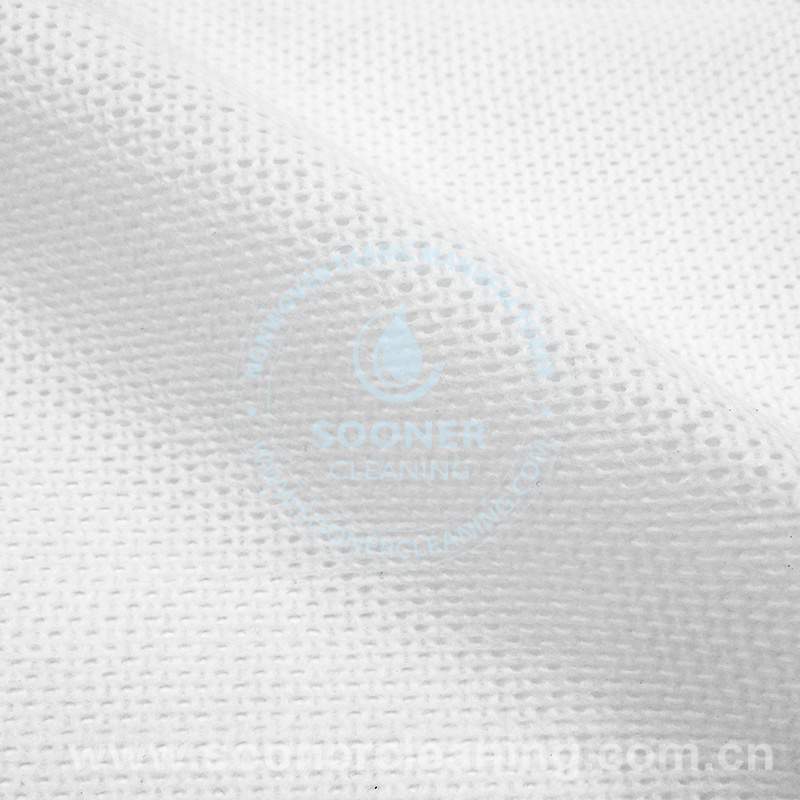With the growing awareness of environmental protection and the concern of environmental pollution caused by traditional plastic products,
Biodegradable Spunlace Nonwoven, as a new type of environmentally friendly material, is becoming a popular choice for the medical, personal care, and packaging industries due to its biodegradability, high strength, and a wide range of application scenarios. In this article, we will discuss the characteristics, production process, application areas and market prospects of this material to help enterprises seize the opportunities for sustainable development.
Biodegradable Spunlace Nonwoven is a nonwoven fabric made by hydroentanglement process (interweaving fibres under high pressure water flow), and its core raw material is biodegradable polymer material. Unlike traditional petroleum-based nonwoven fabrics, it can be decomposed by microorganisms into water, carbon dioxide and biomass in the natural environment, reducing long-term pollution of the ecosystem59.
Key Features:
Environmentally friendly: meets international degradation standards such as EU EN 13432, with a controlled decomposition cycle (usually 3-6 months).
High breathability and softness: the hydroentanglement process makes the fibres more evenly aligned, making it suitable for application scenarios with direct skin contact.
Multifunctionality: Antibacterial and waterproof functions can be achieved by adjusting the ratio of raw materials.
II.Core advantages of Biodegradable Spunlace Nonwoven
1. Solve the environmental pain point of traditional materials
Traditional nonwoven fabrics rely on petroleum-based plastics (e.g. polypropylene), which take hundreds of years to degrade, while biodegradable materials can be decomposed in just a few months under composting conditions, significantly reducing the risk of microplastic pollution.
2. Meeting policy and market demand
Many countries around the world have enacted legislation to restrict the use of single-use plastics (e.g., the European Union's ‘Plastic Ban’), and enterprises can comply with the law by adopting biodegradable materials, as well as enhance their brand image through the ‘Green Label’ to attract environmentally friendly consumers.
3. Technological breakthroughs and cost optimisation
In recent years, the mass production of PLA and other raw materials has reduced costs (down 30% compared to five years ago), and the improvement of the hydroentanglement process has improved the strength of the material, so that it can be used in wet wipes, dressings and other high-demanding areas instead of the traditional non-woven fabrics.
III.Application Scenarios and Industry Cases
1. Medical and sanitary products
Medical dressings: PLA-based spunlace is biocompatible, suitable for wound care, and can be naturally degraded after surgery to reduce secondary trauma.
Disposable hygiene products: such as biodegradable wet wipes and mask liners, to meet consumers' needs for both safety and environmental protection.
2. Personal care and cosmetics
Make-up remover pads and mask bases: soft and skin-friendly features enhance the user experience, and brands can attract the high-end market by claiming ‘zero plastic’.
3. Packaging and Agriculture
Eco-packaging bags: replace traditional plastic packaging and are suitable for short-cycle packaging of food and electronic products.
Agricultural mulch film: no need to recycle after degradation, reducing soil pollution.
IV.Production process and quality control
1. Key steps of hydroentanglement process
Fibre opening and mixing: mix PLA staple fibre with wood pulp fibre to enhance the toughness of the material.
Hydroentanglement: High-pressure water flow makes the fibres intertwine and form a uniform mesh structure.
Post-processing: add antimicrobial agent or waterproof coating to meet specific functional requirements.
2. Certification and Testing
Degradation performance test: ASTM (composting conditions) or ISO (aerobic biodegradation) certification is required.
Physical property test: tensile strength, air permeability and other indicators need to comply with industry standards (e.g. medical dressings).
V. Frequently Asked Questions (FAQ)
Q1: What are the degradation conditions of Biodegradable Spunlace Nonwoven?
It needs to be in industrial composting environment to decompose quickly, and the degradation time may be extended in natural environment.
Q2: Is the cost higher compared to traditional nonwoven fabrics?
Currently, the cost of PLA-based materials is still 20-30% higher, but large-scale production and policy subsidies are narrowing the gap.
VI. Conclusion
Biodegradable Spunlace Nonwoven is not only an innovation in material technology, but also the key for enterprises to practice social responsibility and seize the first opportunity of green economy.
Take action now: contact eco-friendly material suppliers, get free samples, and start a new chapter of sustainable development!


